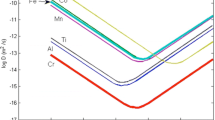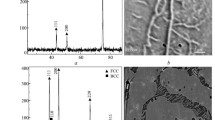Abstract
Fe-Cr binary alloys have been oxidized in a stream of oxygen containing different amounts of water vapor at 900–1000°C to study the effects of water vapor. The Fe-Cr alloys exhibit an initial protective behavior due to formation of a Cr-rich scale and followed by a nonprotective breakaway oxidation due to formation of iron-rich scale. The appearance of the breakaway oxidation was very sensitive to the water vapor content in the atmosphere. The higher the water vapor content, the earlier the breakaway oxidation takes place. Increasing the oxidizing temperature or decreasing the Cr content in the alloys facilitate an earlier breakaway oxidation. The breakaway oxidation was inhibited effectively by surface-applied CeO2 particles before oxidation. The oxide scales were examined and analyzed by optical metallography, X-ray diffraction, SEM, and EPMA. A mechanism of the effects of water vapor has been proposed.
Similar content being viewed by others
References
P. Kofstad,High-Temperature Corrosion (Elsevier Applied Science, London, 1988), p. 382.
I. Kvernes, M. Oliveria, and P. Kofstad,Corros. Sci. 17, 273 (1977).
C. T. Fujii and R. A. Meussner,J. Electrochem. Soc. 111, 1215 (1964).
E. A. Gulbransen and T. P. Copen,Nature (London),186, 959 (1960).
R. A. Rapp,Metall. Trans. A15, 765 (1984).
A. S. Khanna and P. Kofstad,Proc. Ilth Inter. Corros. Congress, Florence, Italy, April 26,4, 45 (1990).
P. Kofstad,High Temperature Corrosion (Elsevier Applied Science, London, 1988), p. 257.
P. Kofstad,Oxid. Met. 24, 265 (1985).
D. L. Douglass, P. Kofstad, A. Rahmel, and G. C. Wood,Oxid. Met. 45, 529 (1996).
R. Hussey, P. Papaiacovou, and J. Shen,Mater. Sci. Eng. A120, 147 (1989).
J. Shen, T. Li, and L. Zhou,Corros. Sci. Prot. Technol. 4, 289 (1992).
M. J. Bennett and A. T. Tuson,Mater. Sci. Eng. A116, 79 (1989).
J. R. Nicholls and P. Hancock, inThe Reactive-Element Effect, E. Lang, ed. (Amsterdam, Elsevier, 1989), p. 195.
H. Jin, M. Li, T. Li, and J. Shen,J. Chin. Soc. Corros. Prot. (to be published).
Author information
Authors and Affiliations
Rights and permissions
About this article
Cite this article
Jianian, S., Longjiang, Z. & Tiefan, L. High-temperature oxidation of Fe-Cr alloys in wet oxygen. Oxid Met 48, 347–356 (1997). https://doi.org/10.1007/BF01670507
Received:
Revised:
Issue Date:
DOI: https://doi.org/10.1007/BF01670507




